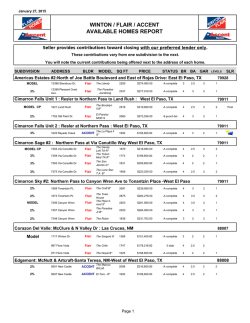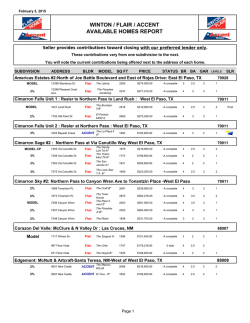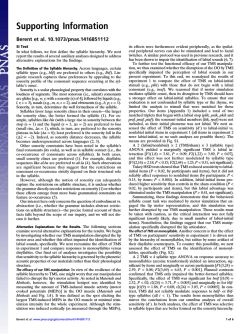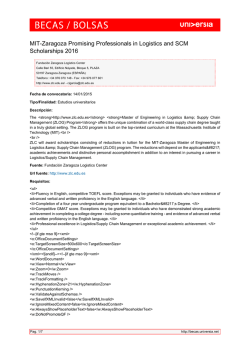
Hola ¿cómo estás?
Talk and I will listen Show me and I will understand But take me in and I will learn (Native American quote) ¡HOLA CLASE! ¿CÓMO ESTÁN? BIENVENIDOS A LA CLASE DE ESPAÑOL NIVEL 1 This is a Review PowerPoint of Chapter One By: Edris Brannen BASIC QUESTIONS AND KNOWLEDGE ABOUT THE SPANISH LANGUAGE What language does Spanish and English share in common? 2. What are cognate words? Give an example. 3. What are false cognate words? Give an example. 4. How many countries have Spanish as their official language? 5. What is the country with the most Spanish speakers in the world? And the second one? 6. Does Spain speak any other languages? If so, Can you name them? 7. In your opinion, Why is it important to learn to speak Spanish? 1. GUIDELINES FOR PLACING WRITTEN ACCENTS IN SPANISH Acento prosódico All Spanish words of more than one syllable have one syllable that is stressed more than the others, in pronunciation. This is called acento prosódico (oral accent). No written symbol is required to indicate this stress. e.g. lago (In pronouncing this word, the syllable la is stressed more than the syllable go, and no written symbol is required to indicate this stress) Acento ortográfico Some Spanish words also require a written accent over the vowel of the syllable with the greatest stress. This is called acento ortográfico (written accent). This accent is indicated in writing with the following symbol: ´ (note that is from right to left). e.g. música (In writing this word the ´ must be placed over the u, in the syllable with greatest stress, mu. N.B. Not all words carry a written accent. WORDS THAT DO NOT REQUIRE A WRITTEN ACCENT (ACENTO ORTOGRÁFICO) The majority of words in Spanish do not require a written accent. The words that do not carry a written accent can be put into three groups, as follows: Words with more than one syllable that end in a vowel or n or s AND are stressed on the second-to-last syllable. e.g. mañana, casi, decide, necesito, ventanas, escriben Words with more than one syllable that end in a consonant, other than n or s, AND are stressed on the last syllable. e.g. popular, eficaz, contestar, felicidad, Marisol Words with only one syllable (with a few exceptions). e.g. yo, es, en, al, del, con, sal, haz, vi WORDS THAT REQUIRE A WRITTEN ACCENT (ACENTO ORTOGRÁFICO) Spanish words that require a written accent can be put into four different groups, as follows: 1.Exceptions to guidelines 1 and 2, above: Words that end in a vowel or n or s BUT are NOT STRESSED on the second-to-last syllable; e.g. Panamá, encontró, compré, colibrí, tabú, jamás, jardín, médico, fantásticas 2. Words that end in a consonant, other than n or s, BUT are NOT STRESSED on the last syllable. e.g. árbol, azúcar, lápiz, cárcel WORDS THAT REQUIRE A WRITTEN ACCENT (CONTINUED) Words with stressed weak vowels in hiatus. (Hiatus: The separation of a weak vowel (i or u) so as to form a separate syllable in what would otherwise be a diphthongs or a triphthong.) Note: A diphthong is a combination of a weak vowel (i or u) and a strong vowel (a, e, or o), or two weak vowels in the same syllable. A triphthong is a combination of two weak vowels and a strong vowel in the same syllable. e.g. oír, reír, sociología, Raúl, continúo WORDS THAT REQUIRE A WRITTEN ACCENT (CONTINUED) Some words with similar spelling but different meaning or grammatical function. Note: Most of these words are monosyllables and are the exceptions referred to above. e.g. el (the) and él (he or him), si (if) and sí (yes), tu (your) and tú (you) WORDS THAT REQUIRE A WRITTEN ACCENT (CONTINUED) The words que, cual, quien, cuan, cuanto, como, cuando, and donde when they introduce interrogative or exclamatory expressions. e.g. ¡Qué susto! ¿Cómo estás? ¿Cuánto cuesta? FINAL NOTES Written accents are always placed over vowels, NEVER over consonants. (The tilde in the ñ is not an accent mark.) No word can have more than one written accent. When the stressed syllable of a word requires a written accent and the stressed syllable contains a diphthong, the accent is placed over the second weak vowel (if the diphthong consists of two weak vowels) and over the strong vowel (if the diphthong consists of a weak vowel and a strong vowel). e.g. cuídate, péinate, abrió, coméis, comunicación, comprensión All words ending in ion carry a written accent over the o, but lose the accent when es is added to make them plural. e.g. canción, nación, impresión, BUT canciones, naciones impresiones All words that have a stressed syllable occurring before the second-to –last syllable must carry a written accent over the stressed syllable. e.g. pronóstico, cómpratelo HOW TO WRITE SPANISH PUNCTUATION ON A PC? Lower case Letras minuscula á= Alt + 160 é= Alt + 130 í= Alt + 161 ó= Alt + 162 ú= Alt + 163 ñ= Alt + 164 ü= Alt + 129 Capital letters Letras mayusculas Á = Alt +0193 É = Alt +144 Í = Alt + 0205 Ó = Alt +0211 Ú = Alt +0218 Ñ = Alt + 165 Ü = Alt +164 LET’S SEE HOW IT WORKS You have to HOLD Alt and type the number at the same time, then RELEASE! UPSIDE DOWN QUESTION MARK (¿) AND UPSIDE DOWN EXCLAMATION MARKS (¡) They are punctuation marks used to begin interrogative and exclamatory sentences (or clauses), respectively, in written Spanish. ¡= Alt + 0161 ¿ =Alt +168 (or 0191) HAY HAS TWO MEANINGS; “THERE IS” AND “THERE ARE” © Cengage Learning 2012 P-6 | ¿Cuántos(as) hay? Following the model, tell how many people and objects you see in the illustration. MODELO: Hay cuatro perros. 1. _____________________________________________________________________ 2. _____________________________________________________________________ 3. _____________________________________________________________________ 4. _____________________________________________________________________ 5. _____________________________________________________________________ 6. _____________________________________________________________________ P-7 | ¿Qué hay en la clase? Indicate if each statement is true (cierto) or false (falso) for your classroom. Change the false statements to make them true. Follow the model. MODELO: Hay veinte personas en la clase. Falso. Hay veinticuatro personas. 1. Hay una profesora. _____________________________________________________ 2. Hay quince estudiantes. _________________________________________________ 3. Hay tres computadoras. _________________________________________________ 4. Hay dos mapas. _______________________________________________________ QUESTION WORDS (P.14) All questions words carry accents. The accent indicates that the word is being used as an interrogative. For example; que without an accent means that (e.g., The one that got away.) The word means What only when it appears as ¿Qué? There is no distinction phonetically between “que” and ¿Qué? They both are pronounced the same way. It is like two, to and too in English, you will get it by context. SPANISH INTERROGATIVE PRONOUNS ~ PRONOMBRES INTERROGATIVOS Note that this pronouns only have ONE form! ¿QUÉ? (what? which?) ¿CÓMO? (how?, what?) ¿CUÁNDO? (when?) ¿DÓNDE? ¿POR QUÉ? (why?) Porque (because) (where?) ¿A QUÉ? (at what?) ¿DE DÓNDE? (where from?) SPANISH INTERROGATIVE PRONOUNS ~ PRONOMBRES INTERROGATIVOS Note that these pronouns have TWO forms (depending if the noun or subject is singular or plural, the interrogative pronoun must agree in number) Singular and Plural ¿QUIÉN/ QUIÉNES? (who?) ¿CUÁL/ CUÁLES? (which one / which ones?) ¿DE QUIÉN/ QUIÉNES ? (whose?) ¿PARA QUIÉN/ QUIÉNES? (for whom?) SPANISH INTERROGATIVE PRONOUNS ~ PRONOMBRES INTERROGATIVOS ¿Cuál? (Which?) is used ¿Cuál es tu nombre? far more frequently in Spanish than in English. ¿Cuál es tu número de It has the same meaning teléfono? as What? When someone’s name, address, or telephone ¿Cuál es tu dirección? number is being asked. When it refers to a plural ¿Cuáles son tus amigos? noun, it becomes ¿Cuáles? SPANISH INTERROGATIVE PRONOUNS ~ PRONOMBRES INTERROGATIVOS ¿Cuánto(a)? and ¿Cuántos(as)? must agree in number (singular or plural) and gender (masculine or feminine) with the nouns they describe. ¿Cuántos hombres hay en la clase? How many men are in the class? ¿Cuántas personas hay en tu familia? How many people are in your family? ¿Cuánto cuesta la silla? How much does the chair costs? ¿CUÁNTO/ CUÁNTA? (how much?) ¿CUÁNTOS/ CUÁNTAS? (how many?) ¡A PRACTICAR! Nombre ________________________________ Fecha ___________________ P-8 | Preguntas Read the answers the other party guests give and then write the appropriate questions. Follow the model. MODELO: ¿De dónde eres? Soy de España. 1. _____________________________________ Mi número de teléfono es el 765-4589. 2. ______________________________________ Hay veinticinco personas en la fiesta. 3. _______________________________________ Estoy bien, gracias. 4. _______________________________________ Me llamo Claudia. 5. _______________________________________ Soy la profesora. P-9 | Preguntas Complete each question with an appropriate question word and then answer it. Follow the model. MODELO: ¿Cómo estás? Muy bien. 1. ¿ ______________________ te llamas? _____________________________ 2. ¿ _______________________ tal? __________________________________ 3. ¿De _____________________ eres? ________________________________ P-10 | Hacer preguntas Use the following question words and verbs to create three questions that you will ask your partner. Write his/her responses. Follow the model. MODELO: ¿Cuántas personas hay en la clase? Hay veinte personas. Interrogativos: Verbos: ¿De dónde? / ¿Quién? / ¿Cuánto(a)(s)? / ¿Cuál? ser / hay 1. _____________________________________________________________________ 2. _____________________________________________________________________ 3. _____________________________________________________________________ WHAT IS A PRONOUN? It’s a word used instead of a noun (or a phrase containing a noun) Example: `He', `it', `who', and `anything' are pronouns. When the pronoun is the subject (the person doing the action) of the sentence, it is called a Subject Pronoun. Example: Bob is swimming. He is swimming. WHAT ARE THE ENGLISH SUBJECT PRONOUNS? Singular Plural 1st person I We 2nd person You You 3rd person He, She, It They ENGLISH SUBJECT PRONOUNS AND THEIR SPANISH EQUIVALENTS Spanish subject pronouns are similar to English, but there are some differences. Singular Plural I = Yo We = nosotros (m) Nosotras (f) 2nd person You (familiar) = tú You (plural, familiar) = vosotros vosotras 3rd person He = él She = ella You (formal) = Usted (Ud.) They (m) = Ellos They (f) = Ellas You (plural) = Ustedes (Uds.) 1st person THE FIRST PERSON SINGULAR PRONOUN “YO” “Yo” means “I” and is used in the same way as in English. Yo soy americano. Yo soy estudiante. Note that it is not capitalized unless it starts a sentence: Mi amigo y yo… SECOND PERSON SINGULAR PRONOUN TÚ Tú means you (familiar/ informal) Used when talking to someone familiar We’ll learn more about this in a moment. 3RD PERSON SINGULAR MASCULINE ÉL Él = he It is used when talking ABOUT a boy/guy/man. used in the same way as its English counterpart: Jorge es mexicano. Él es de Guadalajara. DON’T forget the accent mark. If you do, you are actually writing the Spanish word for “the” él = he el = the 3RD PERSON SINGULAR FEMININE ELLA Ella = she It is used when talking ABOUT a girl/woman. used in the same way as its English counterpart: Rosa es mexicana. Ella es de Acapulco. Please pronounce it correctly. It sounds like (eh-yah) not (el-lah) Remember ll= y sound. FORMAL YOU USTED (UD.) Usted means you (formal) Used when talking to someone you should respect. Abbriviated Capital U lower case d period. (Ud.) Considered a 3rd person singular pronoun. We’ll learn more about this pronoun in a moment. THE FIRST PERSON PLURAL PRONOUN “NOSOTROS / NOSOTRAS” Use nosotros/ nosotras to talk about a group of people that includes you. in English we have one word to talk about “we,” but in Spanish, we distinguish between “we” masculine and feminine: Juan: “Mi hermano y yo somos de Argentina. Nosotros vivimos en Buenos Aires.” Juana: “Mi hermana y yo somos de Bolivia. Nosotras vivimos en La Paz.” use the masculine pronoun if it refers to a mixed group: Juan: “Mi hermano, mi novia, y yo somos de Argentina. Nosotros vivimos en Buenos Aires.” Juana: “Mi hermana, mis padres, y yo somos de Bolivia. Nosotros vivimos en La Paz. 3RD PERSON PLURAL MASCULINE ELLOS Ellos = They (masculine) It is used when talking ABOUT a group of boys/guys/men or a mixed group. used in the same way as its English counterpart: Jorge y Pepe son mexicanos. Ellos son de Guadalajara. Jorge y Ana son alumnos. Ellos son amigos también. Please pronounce it correctly. It sounds like (eh-yohs) not (el-lohs) Remember ll= y sound. 3RD PERSON PLURAL FEMININE ELLAS Ellas = They (feminine) It is used when talking ABOUT a group of only females. used in the same way as its English counterpart: Sofía y Ana son alumnas. Ellas son amigas también. Please pronounce it correctly. It sounds like (eh-yahs) not (el-lahs) Remember ll= y sound. FORMAL YOU PLURAL USTEDES (UDS.) Abbriviated Capital “U”, lower case “d”, lower case “s” period. (Uds.) Considered a 3rd person plural pronoun. We’ll learn more about this pronoun in a moment. YOU, YOU, AND YOU In English, there is only one “YOU”. It is singular and plural, masculine and feminine, formal and informal Note: y’all or you all is not standard English, but we will use it to help learn the Spanish forms of “you”. In Spanish there are 5 ways to express “you” tú usted (Ud.) vosotros vosotras ustedes (Uds.) DIFFERENCES – YOU: TÚ VS. USTED Let’s look at the singular forms first. Each one has a specific time when it used. If you use the wrong one, it can be offensive to the person with whom you are speaking. Tú = you (informal/familiar) Usted (Ud.) = you (formal) Use “tú” when talking to people with whom you are on a first name basis. friends family small children people younger than you pets Use “Usted” when talking with people to whom you should show respect. People in authority (police, teachers, bosses, etc.) Strangers Acquaintances Adults DIFFERENCES – Y’ALL In Spanish there are three ways to say “all of you” Vosotros Vosotras Ustedes (Uds.) Vosotros/vosotras are the plural forms of tú. Ustedes is the plural form of usted. Vosotros is used when talking to a familiar group of males or a mixed group. Vosotras is the feminine form of vosotros and is used when the entire group is female These two familiar forms are used primarily in Spain. We will not use vosotros/as in class, but you need to be aware of it. REVIEW Yo = I First person singular Not capitalized unless the first word of the sentence Used to talk ABOUT yourself Tú = You (singular, informal/familiar) Second person Singular Use it to talk TO a person that is a friend or family member Third person singular Él = he Don’t forget the accent Use it to talk ABOUT a guy. Ella = she Use it to talk ABOUT a girl. Watch the pronunciation. Ud. = You (singular, formal) Use it to talk TO a person that is due respect. Nosotros/as = we First person plural distinguish between “we” masculine and feminine Used to talk ABOUT yourself and friends Vosotros/as = You (singular, familiar) Second person Plural Use it to talk TO a group of friends or family members. Third person plural Ellos = They (masculine) It is used when talking ABOUT a group of boys/guys/men or a mixed group. Ellas = They (feminine) It is used when talking ABOUT a group of only females. Uds. = You (plural) Use it to talk TO a group of people ¡ A PRACTICAR! P-1 | Identificar Write the pronoun you would use to refer to the following people. Follow the model MODELO: el profesor él 1. los estudiantes ________________ 6. las computadoras _________________ 2. la profesora ________________ 7. you (un amigo) __________________ 3. el muchacho ________________ 8. you (un pr ofesor) _________________ 4. Juan y yo ________________ 9. Juan y María ____________________ 5. Ana y Miranda _______________ 10. I (myself) _______________________ P-2 | Más pronombres Complete the conversation below with the appropriate pronouns (yo, tú, él, ella, Ud., nosotros, nosotras, Uds., ellos, ellas). Follow the model. MODELO: ANITA : SR. FALCÓN: ANITA: ¿Cómo está Ud., Sr. Falcón? SR. FALCÓN: Bien, gracias. ¿Y tú, Anita? ANITA: Bien, gracias. ¿De dónde son Alfredo y Graciela, Sr. Falcón? ____________ son de Sudamérica. ____________ es argentino, y ____________ es colombiana. ANITA : SR. FALCÓN: ANITA : SR. FALCÓN: Y ____________ Sr. Falcón, ¿de dónde es? ¿ ____________ ? Soy de Costa Rica. Y la señora Falcón, ¿de dónde es ____________? De Panamá. ____________ y ____________ somos centroamericanos. ¿Y ____________? ¿De dónde eres, Anita? ANITA : ____________ soy mexicana; soy de la Ciudad de México. EL VERBO SER “SER O NO SER, ESA ES LA CUESTIÓN” Singular Plural Yo soy Tú eres Él es Ella es Usted (Ud.) es Nosotros/as somos Vosotros/as sois (Spain only) Ellos/ Ellas son Ustedes (Uds.) son Keep always in mind your subject (yo, tú,él…) when you are making your sentences THERE ARE TWO VERBS THAT MEAN «TO BE» IN SPAISH. THESE ARE THE USES OF SER: To identify people and things To express nationality; with de to express origin Ella es doctora. Son cubanos. Son de La Habana. With de to tell of what material something is made Este bolígrafo es de plástico. With para to tell for whom something is intended El regalo es para Sara. To tell time With de to express possession Son las once. Es la una y media. Es de Carlota. Ramona es inteligente. With adjectives that describe basic, inherent characteristics To form many generalizations Es necesario llegar temprano. Es importante estudiar. CREATE IMPLE SENTENCES USING THE VERB “SER.” EJ: YO SOY UN OPTIMISTA, INTELIGENTE PERO REBELDE. YO NO SOY INTROVERTIDO. estudiante cruel responsible optimista paciente importante inteligente pesimista flexible tolerante elegante intovertido/a romántico/a sentimental egoísta moderno/a espectacular extravagante realista rebelde P-3 | ¿De dónde son? Answer the questions below according to the indications, using the verb ser. MODELO: ¿De dónde es el profesor? (Guatemala) El profesor es de Guatemala. 1. ¿De dónde son los estudiantes? (México) ___________________________________ 2. ¿De dónde eres tú? (España) _____________________________________________ 3. ¿De dónde es Mariela? (Costa Rica) _______________________________________ 4. ¿De dónde son ustedes? (Cuba) ___________________________________________ 5. ¿De dónde es el padre? (Puerto Rico) ______________________________________ 6. ¿De dónde es el señor Ortega? (Chile ) ______________________________________ 7. ¿De dónde soy? (Venezuela) _____________________________________________ 8. ¿De dónde es… ? ______________________________________________________ P-4 | Descripciones Form complete sentences using the verb ser. Follow the model. MODELO: Javier / arrogante Javier es arrogante. 1. el profesor / serio ______________________________________________________ 2. tú / romántico _________________________________________________________ 3. las clases / interesantes __________________________________________________ 4. yo / inteligente ________________________________________________________ 5. mis amigos y yo /cómicos LOS NÚMEROS DEL 30 AL 0 EN ESPAÑOL 30,29,28,27,26,25, 24,23,22,21,20,19, 18,17,16,15,14,13, 12,11,10,9,8,7,6,5, 4,3,2,1,0 Important note for spelling! 11 : once 12 : doce 13 : trece 14 : catorce Note the 15 : quince accent mark on 16 : dieciséis number 16 17 : diecisiete 18 : dieciocho 19 : diecinueve 20 : veinte Spanish numbers 16 through to 19 are actually contractions. For example, the Spanish for 16 - dieciséis - literally means ten and six, but is joined together, as shown below: dieciséis = diez y seis diecisiete = diez y siete dieciocho = diez y ocho diecinueve = diez y nueve 21 : veintiuno 22 : veintidós Note the 23 : veintitrés accent marks on 24 : veinticuatro numbers 25 : veinticinco 22,23 and 26. 26 : veintiséis 27 : veintisiete 28 : veintiocho 29 : veintinueve 30 : treinta You'll notice that, as with the cardinal numbers 16 to 19, the Spanish numbers 21 to 29 are also contractions, but this time of the Spanish for twenty and one, etc. veintiuno = veinte y uno veintidós = veinte y dos, etc P-5 | ¿Cuál es el próximo número? Complete each number sequence. Follow the model. MODELO: uno, dos, tres, cuatro 1. dos, ___________________________ , seis, ocho, diez 2. tres, seis, nueve, _______________________________ 3. cinco, diez, ___________________ , veinte, veinticinco 4. cuatro, __________________________ , doce, dieciséis 5. diez, veinte, __________________________________ Un problema para Einstein 6-4+11-3+19-15+13-9+10-3=? SPANISH DEFINITE ARTICLES UNLIKE ENGLISH, WHICH HAS ONLY ONE DEFINITE ARTICLE “THE", SPANISH HAS 4 DEFINITE ARTICLES: Spanish Definite Articles Singular Plural Feminine la las Masculine el los DEFINITE ARTICLES: Plural ending with: (a, e, i, o, u) * In Spanish, if a noun ends in a vowel (a, e, i, o, u), just add the letter S to the singular form of the noun to make it plural. Here are two groups of nouns: El gato El perro La madre La tía los gatos los perros las madres las tías DEFINITE ARTICLES: Plural ending with consonant! In Spanish, if a noun ends in a consonant (for example, l, n, r), add the letters ES to the singular form of the noun to make it plural. El animal El color La flor La lección los animales los colores las flores las lecciones NOTE: They are exceptions exceptions to the rules: La leche (milk) las leches El programa los programas La radio las radios ***When a singular noun ends in Z, the Z changes to C in the plural: la actriz las actrices el lápiz los lápices When a singular noun ends in a syllable with an accent mark, the accent mark is dropped in the plural: la lección las lecciones SPANISH INDEFINITE ARTICLES While we have (a / an / some) in English as indefinite articles, we also have un/ una. unos/ unas in Spanish . In general, whenever un or una are used in Spanish, you need to use "a" or "an“, *“one” to say the equivalent in English. Spanish Indefinite Articles Singular Plural Masculine un unos Feminine una unas The number for one in Spanish is uno. It loses its o and becomes un when used before a masculine noun. When used before a feminine noun it changes to una. For example: un niño ..... one boy una niña ..... one girl You should use uno when counting generically, as in: one, two, three, four, etc uno, dos, tres, cuatro, etc You should use un or una when counting specifically, as in: one banana, one apple, etc un plátano, una manzana, etc UN, UNA = ONE, A, AN UNOS, UNAS = SOME Masculine, singular indefinite article UN Masculine, plural indefinite article UNOS Un árbol grande. ( A big tree OR One big tree.) Unos árboles grandes. ( Some big trees.) Un niño alto. ( A tall boy OR One tall boy) Unos niños altos. ( Some tall boys) Feminine, singular indefinite article UNA Feminine, plural indefinite article UNAS Una flor amarilla. ( A yellow flower OR One yellow flower.) Unas flores amarillas. ( Some yellow flowers.) Una niña alta. ( A tall girl OR One tall girl) Unas niñas altas. ( Some tall girls) Un trabalengua R con R cigarro, R con R barril, rápido corren los carros cargados de azúcar al ferrocarril. ¿Preguntas? Y COLORÍN COLORADO ESTE REPASO DEL CAPÍTULO PRELIMINAR SE HA TERMINADO ……….….¡ADÍOS!
© Copyright 2025





